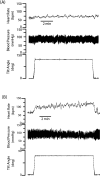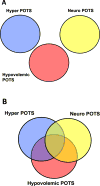Postural tachycardia syndrome - Diagnosis, physiology, and prognosis
- PMID: 29523389
- PMCID: PMC6113123
- DOI: 10.1016/j.autneu.2018.02.005
Postural tachycardia syndrome - Diagnosis, physiology, and prognosis
Abstract
Postural tachycardia syndrome (POTS) is a heterogeneous clinical syndrome that has gained increasing interest over the past few decades due to its increasing prevalence and clinical impact on health-related quality of life. POTS is clinically characterized by sustained excessive tachycardia upon standing that occurs in the absence of significant orthostatic hypotension and other medical conditions and or medications, and with chronic symptoms of orthostatic intolerance. POTS represents one of the most common presentations of syncope and presyncope secondary to autonomic dysfunction in emergency rooms and in cardiology, neurology, and primary care clinics. The most sensitive method to detect POTS is a detailed medical history, physical examination with orthostatic vital signs or brief tilt table test, and a resting 12-lead electrocardiogram. Additional diagnostic testing may be warranted in selected patients based on clinical signs. While the precise etiology remains unknown, the orthostatic tachycardia in POTS is thought to reflect convergence of multiple pathophysiological processes, as a final common pathway. Based on this, POTS is often described as a clinical syndrome consisting of multiple heterogeneous disorders, with several underlying pathophysiological processes proposed in the literature including partial sympathetic neuropathy, hyperadrenergic state, hypovolemia, mast cell activation, deconditioning, and immune-mediated. These clinical features often overlap, however, making it difficult to categorize individual patients. Importantly, POTS is not associated with mortality, with many patients improving to some degree over time after diagnosis and proper treatment. This review will outline the current understanding of diagnosis, pathophysiology, and prognosis in POTS.
Keywords: Diagnosis; Etiology; Orthostatic intolerance; Postural tachycardia syndrome.
Copyright © 2018 Elsevier B.V. All rights reserved.
Figures




References
-
- Sheldon RS, Grubb BP, 2nd, Olshansky B, Shen WK, Calkins H, Brignole M, Raj SR, Krahn AD, Morillo CA, Stewart JM, Sutton R, Sandroni P, Friday KJ, Hachul DT, Cohen MI, Lau DH, Mayuga KA, Moak JP, Sandhu RK, Kanjwal K. 2015 heart rhythm society expert consensus statement on the diagnosis and treatment of postural tachycardia syndrome, inappropriate sinus tachycardia, and vasovagal syncope. Heart Rhythm. 2015;12:e41–63. - PMC - PubMed
-
- Freeman R, Wieling W, Axelrod FB, Benditt DG, Benarroch E, Biaggioni I, Cheshire WP, Chelimsky T, Cortelli P, Gibbons CH, Goldstein DS, Hainsworth R, Hilz MJ, Jacob G, Kaufmann H, Jordan J, Lipsitz LA, Levine BD, Low PA, Mathias C, Raj SR, Robertson D, Sandroni P, Schatz I, Schondorff R, Stewart JM, van Dijk JG. Consensus statement on the definition of orthostatic hypotension, neurally mediated syncope and the postural tachycardia syndrome. Clin Auton Res. 2011;21:69–72. - PubMed
-
- Benrud-Larson LM, Sandroni P, Haythornthwaite JA, Rummans TA, Low PA. Correlates of functional disability in patients with postural tachycardia syndrome: Preliminary cross-sectional findings. Health Psychol. 2003;22:643–648. - PubMed
-
- Benrud-Larson LM, Dewar MS, Sandroni P, Rummans TA, Haythornthwaite JA, Low PA. Quality of life in patients with postural tachycardia syndrome. Mayo Clin Proc. 2002;77:531–537. - PubMed
-
- Robertson D. The epidemic of orthostatic tachycardia and orthostatic intolerance. Am J Med Sci. 1999;317:75–77. - PubMed
Publication types
MeSH terms
Grants and funding
LinkOut - more resources
Full Text Sources
Other Literature Sources
Medical
Miscellaneous

